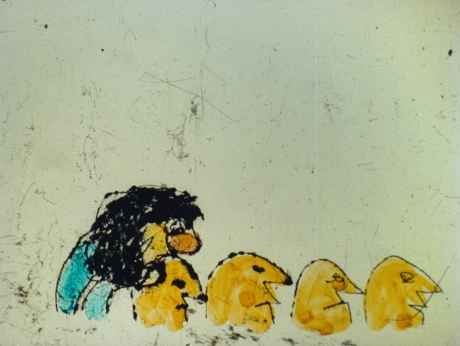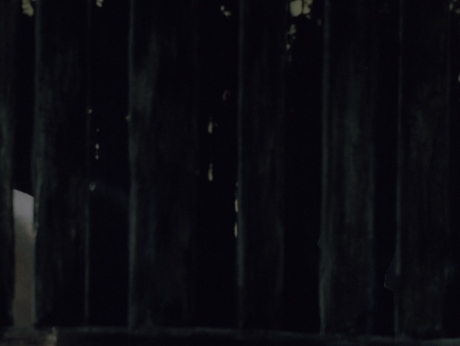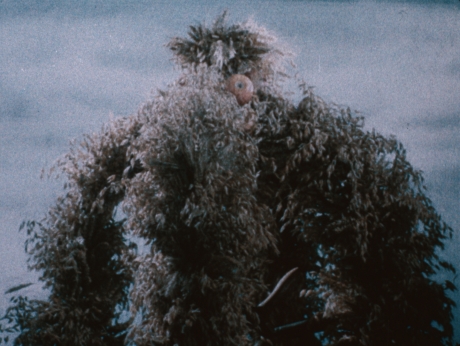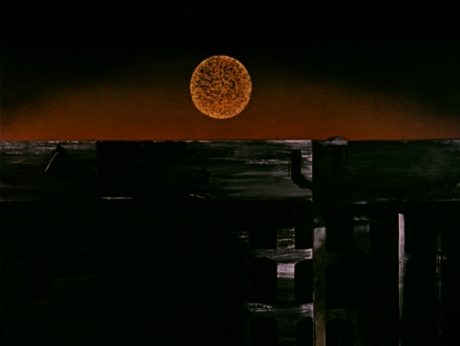
 overview
overview
About the film
Music: Marek Wilczyński
Editor: Krystyna Makarewicz
Production Manager: Leszek Kachel
Production: Animated Film Studio (Cracow)
Rights: National Film Archive
Language: pl
hide tab

 storyline
storyline
A falling barrier stops the traffic before the level crossing, a train will soon be coming. People going towards the barrier stop: a man with a hat, a mother with a child and its backpack, a biker, a man with a briefcase, a motorcyclist... People, whose routine activities have been interrupted, begin to reflect, think about the past and daydream. Birds flapping their wings appear on the screen, one flies up, another falls… After the train departure the barrier goes up again, traffic is resumed, and life goes back to normal...
hide tab

 comment
comment
hide tab



















In contract to his more experienced colleagues, in his debut Kucia created a type of artistic communication which invited the audience to participate in a common creation of the emotional experience conditioned by everyday life. They consisted in suspending one’s participation in the events of reality by: a train trip (“The Return”), a ride in a lift (“The Lift”), waiting in front of a train barrier (“The Barrier”), etc. These moments, which gave a break from life for a longer or short time, gave an opportunity to set in motion the whole richness of inner images, memories, impressions, dreams, imagination, and subconscious impulses. It became a common opinion that Kucia’s work has an inner logic (imposing both the structure of each film and the relations between the films) which sets free real situations and which, despite its subjective character, becomes a basis for an inter-subjective communication with the viewer, opening due to the artistic impulse to experiencing universal emotional states. Bogusław Zmudziński in: „Polski Film Animowany" , Polskie Wydawnictwo Audiowizualne
After realising the well received debut “The Return” (1972; prizes in Grenoble, Melbourne, Oberhausen and Cracow), the continuation “The Lift” (1973; prize in Oberhausen) and “In the Shadow” (1973; distinction in Huesca), with which Jerzy Kucia worked out his original, immediately recognizable character of film writing, the artist directed “The Barrier” (1977), which grounded his strong position in Polish and world animation. This absorbing animation, full of visual poetry, brought him the following prizes: I Prize – ex aequo – at the II International Festival of Animated Films in Espinho (1978), the Bronze Pegasus award at the X Films on Art Festival in Zakopane (1978) and the prize of the Ministry of Culture and Art for his film output in the years 1977-1978. “It seemed to me that it would be wise to choose a track that I could in some way follow” – the artist says in Jerzy Kapuściński’s TV program “Other Cinema”. “The Barrier” is in fact a form of continuation of his previous works. It is quite an accurate saying that Kucia constantly makes the same film, but broadens it and deepens the topics which interest him. What interests him – most of all – is the human being, his psyche, thoughts, dreams, experiences, accomplishments. He makes documents of people’s inner life. “The direct stimulus – continues Kucia in the above program about the beginnings of ‘The Barrier’ – for me was the life of a regular person, nobody special, just a regular person. As it turns out, regular is always special”.
“The Barrier”, in contract to Kucia’s earlier films – “The Return” or “The Lift” – realized in a gloomy, dark colour scheme, shines with intensive colours. Perfectly integrated with the images is the beautiful, pastel piano music by Marek Wilczyński. It is carefully – as always for this director – complemented with natural sounds and dramatic moments of silence.
Three years after “The Barrier” Andrzej Warchał – who was inspired by Kucia – made “A Barred Crossing” (1980) in the Animated Film Studio in Cracow – an absorbing story about a driver who also stopped in front of a closed barrier. His memories are full of political events: the end of the war, important Polish months – October ’56, December ’70, the time of success propaganda. When the barrier rises, the driver, lost in his thoughts, does not move. The other impatient drivers start to beep at him and this turns into a dramatic yell of sirens. Jerzy Armata
A certain change of the problem was brought by the film “The Barrier” (1977). A man is coming close to a level crossing. He stand in front of a closed barrier. On both sides of it people gather, waiting for the opening of the road. This scene from everyday life gives Jerzy Kucia the change to analyze group behaviours and emotional attitudes of people in an extreme situation. An apparently common event seems to be an extreme point for the people waiting and it activates irrational behaviours. Their emotions influence an anonymous observer watching from a near-by house. The nagging sound of train getting closer seems to be a sign of the end of the anticipation, but after a second evokes the image of two pigeons dying in the mind of the observer. The scene of their agony taking place on the window sill is a projection of the mental state caused by the situation by the barrier. The observer separates himself from these drastic thoughts by closing the window. The way he does this shows the contrast between the indifferent attitude towards an extreme event, which is death in Nature, and the reaction of people to the constraints imposed by Civilization. „Kino” nr 9/1983 Wojciech Mischke